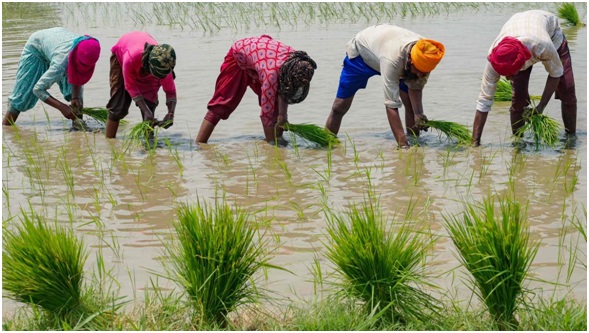Curbs on Rice Exports (The Hindu)

- 31 Aug 2023
Why in the News?
In a move to check domestic rice prices and ensure domestic food security, the Indian government has prohibited the export of white rice, levied a 20% export duty on par-boiled rice till October 15, and permitted the export of Basmati rice for contracts with value of $1,200 a tonne or above.
India's Rice Exports:
- India is the biggest rice seller in the whole world, making up 45% of the global rice market.
- In the months of April and May in 2023, the amount of rice sent out of the country was 21.1% more compared to the same time in the previous financial year.
- Just in May, the export of Basmati rice was 10.86% higher than how much was exported in May of 2022.
- The amount of non-Basmati rice being shipped out has been increasing for three years, and in the year 2022-2023, more Basmati rice was exported than the year before.
- According to the information the government provided, until August 17 this year, the total rice exports (not including broken rice) were 15% more, reaching 7.3 million tonnes.
- This is compared to 6.3 million tonnes during the same time last year.
- Thailand thinks it will produce almost 25% less rice in 2023-2024; Myanmar has stopped sending out raw rice; and it seems like there might be less rice available in Iraq and Iran too.
Rice Production in Current Season:
- The Department of Agriculture and Farmers Welfare has reported that during the Rabi season of 2022-2023, the amount of rice produced was 13.8% lower, reaching 158.95 lakh tonnes.
- This is compared to 184.71 lakh tonnes in the Rabi season of 2021-2022.
- For the Kharif season, the data about planting shows that rice has been planted on 384.05 lakh hectares this year as of August 25.
- This is more compared to 367.83 lakh hectares during the same time last year.
- People in the trading and rice milling business are saying that the new season's rice will start arriving after the first week of September.
- They also mentioned that the effects of El Nino might have some impact on how much rice arrives.
- Rice prices were ?27 per kilogram at this time last year, but now they've gone up to ?33 per kilogram.
Challenges in India’s Rice Export Strategy:
- India managed to export a record-breaking 21 million metric tonnes (MMT) of rice in the fiscal year 2021-22 (FY22), which made up around 41 percent of the global exports in a market of about 51.3 MMT.
- Exporting such large amounts of rice led to a drop in global rice prices by approximately 23 percent in March (compared to the previous year), while other cereal prices like wheat and maize were increasing significantly in the global market. In fact, in FY22, the price for each tonne of common rice exported was only $354, which was lower than the Minimum Support Price (MSP) for rice.
- Buying below MSP or issues with distribution which means that either rice exporters were buying rice (paddy) from farmers and millers at prices below the MSP, or a significant portion of rice provided for free under the PM Garib Kalyan Ann Yojana (PMGKAY) was being sent for export at prices below the MSP.
- Certain states, particularly Punjab, provide free electricity for irrigation, and highly subsidized fertilizers, especially urea, which gives Indian rice an artificial competitive edge in global markets.
What Can Indian Farmers and Consumers Anticipate?
- The government has raised the Minimum Support Price (MSP) for rice, and rice millers are now buying paddy at a price higher than the MSP.
- Because of this, farmers can expect that prices won't go down.
- Limits on exports will make sure that rice prices in the market don't suddenly go up by a lot.
- For people in India who are buying rice, there's a small increase in prices right now, but over time, there will still be enough rice available and prices aren't predicted to go way up.
Actions Taken by the Central Government:
- To control the prices of rice in the country and make sure there's enough food for people here, the Union government has stopped exporting regular (non-basmati) white rice.
- They have also put a 20% tax on exporting partially cooked rice until October 15.
- For Basmati rice, the government says it can be exported if the contract's value is $1,200 per tonne or more.
- Since last September, exporting broken rice has not been allowed.
- However, in some cases, the government can allow exporting broken rice if other countries need it for their food security and if their government asks for it.
Opinions of Rice Exporters:
- Indian par-boiled rice is still competitively priced in the global market, even with the 20% duty added.
- When the world rice market is strong, it can handle higher prices as well. Overall, there's a lot of demand from other countries.
- Countries like Indonesia, which usually sell rice, are now buying (raw rice) from other places.
- According to rice exporters, instead of dividing rice into Basmati and non-Basmati, the government should think about categorizing it as regular rice and special rice for making export decisions.
- Around 12 types of rice have something called Geographical Indication (GI) recognition, and these should be kept separate from general market rules.
- For Basmati rice, the government could have let exports continue or set a minimum value for exports at $900 per tonne.
- Basmati rice is unique, and there will be new rice arriving soon, so there's no real need for restrictions.
- Since Indian rice quality is good and supply is steady, other countries will want it even more in the future.
